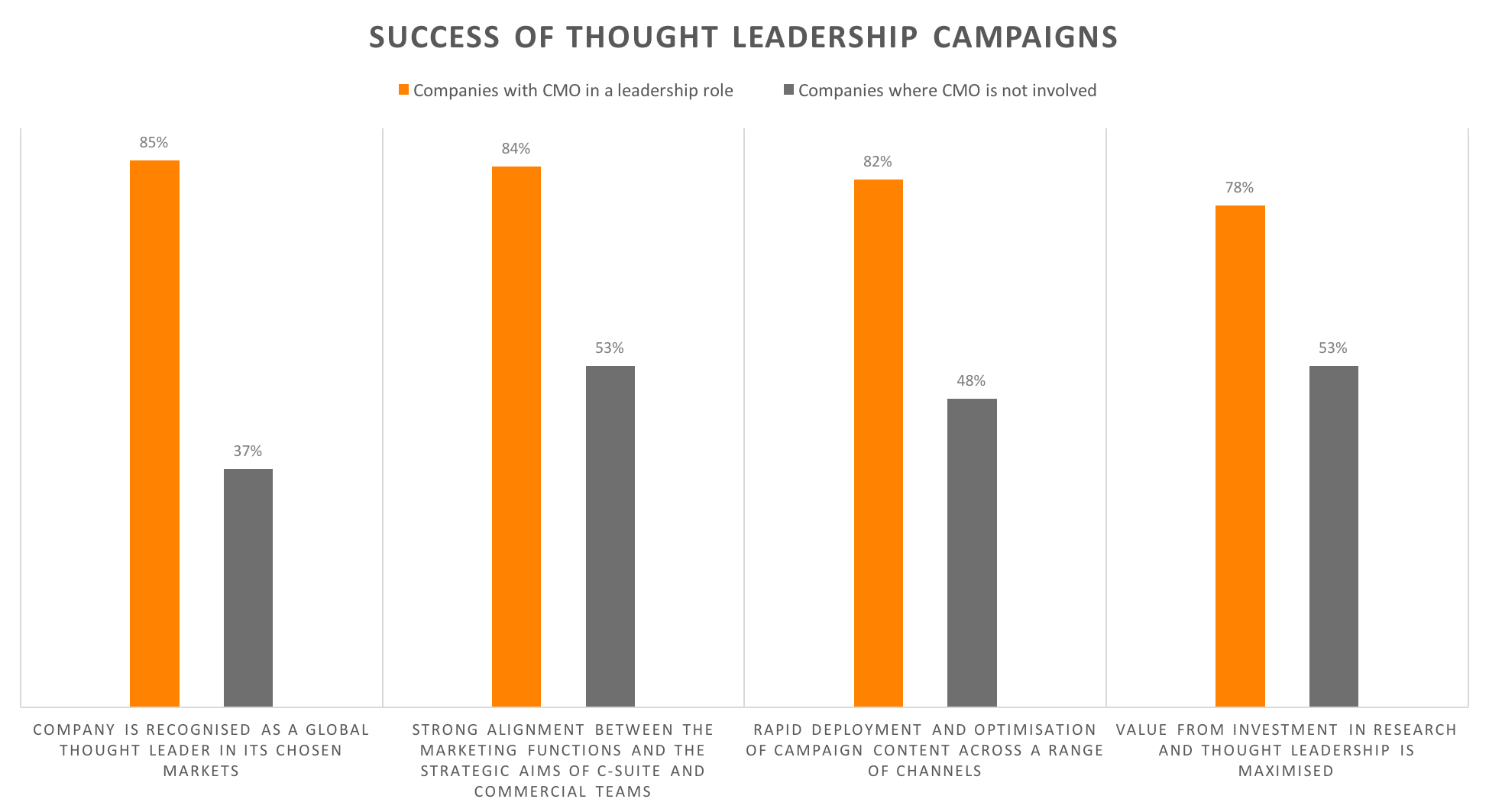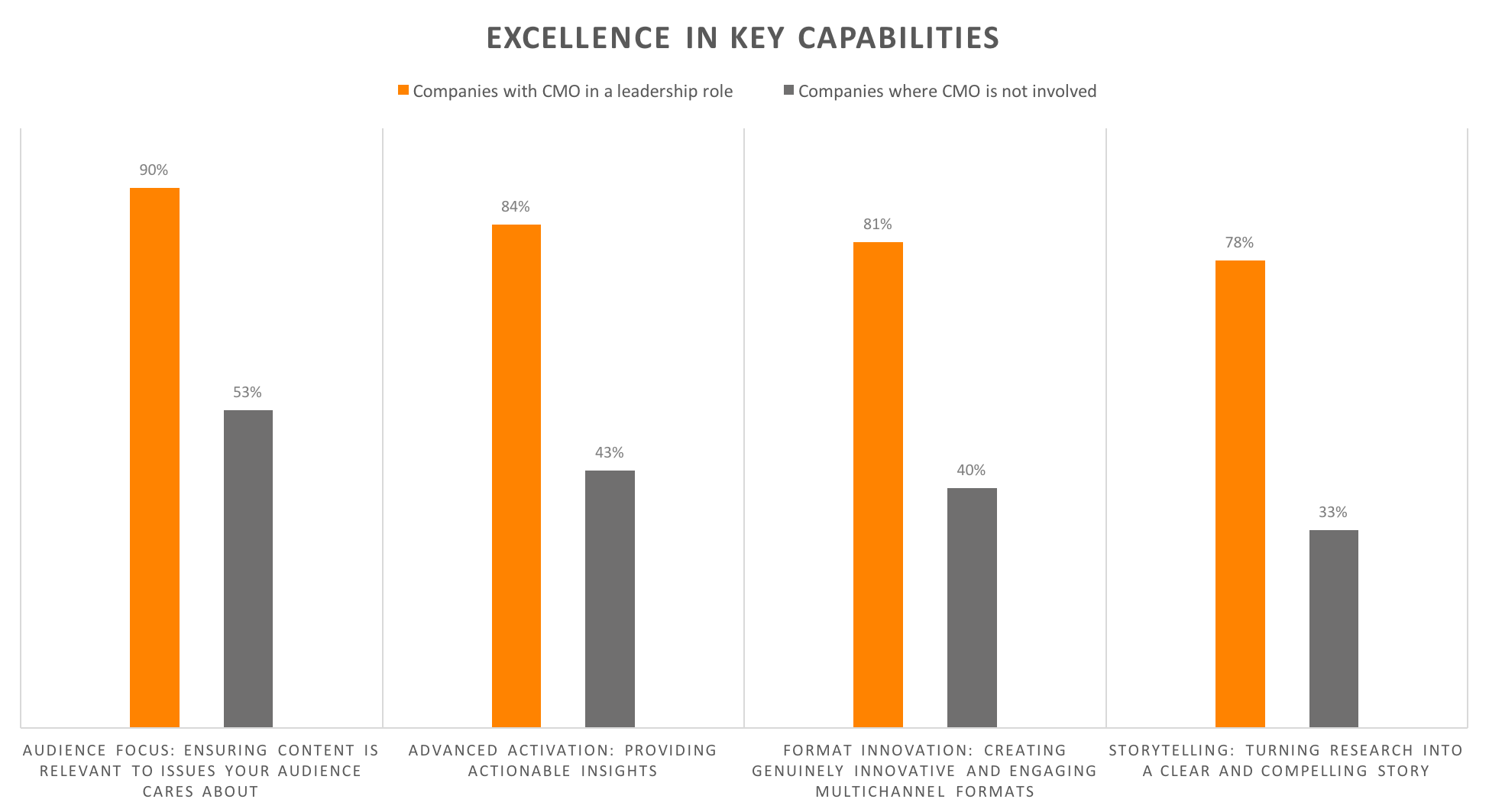How CMOs are reframing thought leadership strategy
We recently explained why we think board-level executives need to own the thought leadership strategy.
And now we’ve got the data to back it up. Our new Thought-Leading Brands research clearly illustrates the benefits of taking a strategic approach to thought leadership, and sheds light on the CMO’s role in creating the right approach. Based on a survey of 360 senior executives involved in thought leadership, it identifies why some companies are massively outperforming their peers in using research and content to achieve their commercial outcomes.
We call these companies the Thought-Leading Brands, and they’re doing things differently from their peers.
One of the most striking contrasts is the rigour of their thought leadership strategy planning. For example, they’re much more likely to consistently audit their content portfolio and to pre-test their choice of topics with their target audiences.
And these leaders are building their strategic skills: 72% of Thought-Leading Brands are investing in strategy and planning skills over the next two years. ![]()
Take it from the top
The Thought-Leading Brands understand that thought leadership strategy needs to be owned at the top: they’re more likely to have a CMO who is heavily engaged with the strategy.
In companies where the CMO takes a leadership role in planning and managing the strategy, 85% say they are already recognised as a global thought leader, compared with just 37% of companies where the CMO is not involved. ![]()
But surely the CMO is always involved in the thought leadership strategy? The research suggests otherwise: 75% of companies in the survey say their CMOs do not head up the strategy. ![]()
In my experience, companies that publish a lot of content often lack a strong vision. With multiple projects commissioned in every part of the business, they need a single guiding force to orchestrate an overarching thought leadership programme.
It’s not easy to come up with a brand-level strategy that is both coherent and takes into account the specific requirements of business units and geographic entities, and there are pros and cons to taking a centralised approach instead of breaking it down by region.
Ultimately, however, it should be the CMO that identifies and coordinates the thought leadership strategy and delivery model that work best for the organisation.
How the best CMOs approach thought leadership
Our research and conversations with leading B2B brands suggest that the CMO’s role is evolving as new trends redefine how companies go to market and engage with their customers.
- They know how to use thought leadership to drive growth
-
-
- Thought leadership has to be aligned with the company’s commercial goals.
-
“It’s time to learn the language of growth and take our place at the leadership table,” says Heather Rim, chief marketing and communications officer at the infrastructure giant AECOM, in a recent article on how corporate comms leaders need to measure success by their impact on customer acquisition, retention and growth.
Marketing leaders have to demonstrate how thought leadership not only enhances corporate reputations, but also increases revenue and profit. ![]()
- They get the positioning right
-
-
- CMOs should ask themselves: in what space do they want their brand to be seen as a thought leader? Where can the organisation add the most insight on topics that are on the corporate agenda?
-
These questions are not always easy to answer, and it takes a strong leader to unite disparate organisations around the right long-term themes. In particular, there needs to be more thoughtful alignment of brand positioning (What’s our vision? What do we stand for?) and the thought leadership strategy (What’s our viewpoint? Where do we add value on the big strategic issues?”).
A great CMO helps the organisation to articulate its view and its value around the issues that keep its customers awake at night.
- They give every campaign a strong purpose
-
-
- Great thought leadership campaigns have a clear business case and objective. Whether your company creates two or 200 thought leadership campaigns a year, it’s vital that each one has its own clear goals and objectives.
-
So there might be campaigns that focus primarily on building reputation – measured in media pick-up, securing meetings, speaking platforms at events and other forms of direct dialogue with the clients – alongside others that are designed to sell products and services. Or perhaps the campaign is designed to support client acquisition (measured, for example, by the number of marketing qualified leads) or enhance account-based marketing (measured by increased customer loyalty and a higher value of renewals).
- They create a scalable delivery model that ensures successful campaign activation
-
-
- The Thought-Leading Brands in our survey are much more likely than their peers to be mastering campaign activation: 75% demonstrate excellence in driving engagement across multiple channels, such as digital, PR, social and face-to-face.
-
They haven’t picked up these capabilities by accident. Leading CMOs are thinking long term, and building up the infrastructure – new skills and emerging technologies – to support insight-led marketing well into the future.![]()
Click here to download our Thought-Leading Brands best practice guide and explore the data.






 Back
Back

 Book a meeting
Book a meeting
 Book a meeting
Book a meeting



